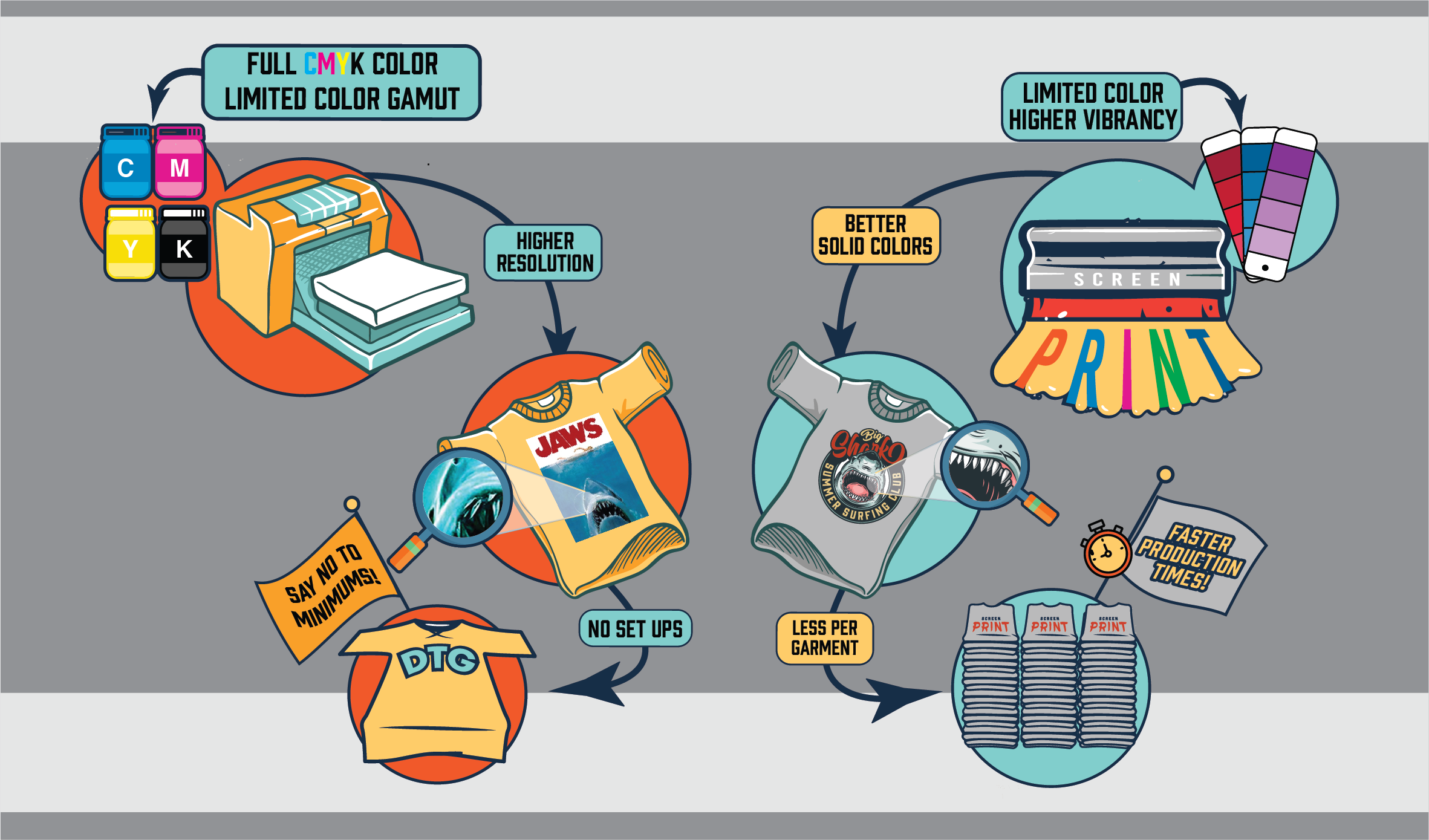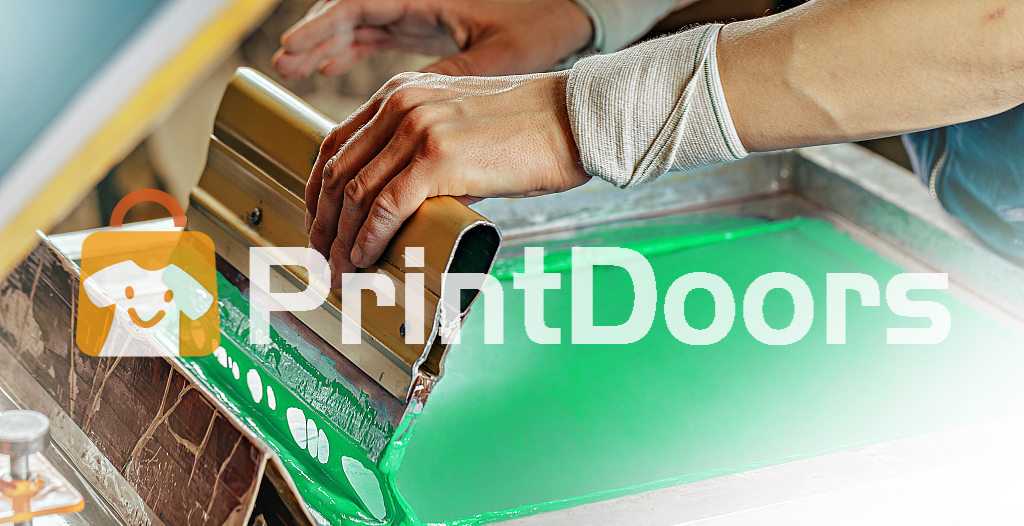The Tx Tees Statements
The Tx Tees Statements
Blog Article
Getting The Tx Tees To Work
Table of ContentsNot known Facts About Tx TeesTx Tees for BeginnersIndicators on Tx Tees You Should KnowNot known Details About Tx Tees Facts About Tx Tees RevealedThe smart Trick of Tx Tees That Nobody is Talking AboutTop Guidelines Of Tx Tees
That brings your total to approximately $1,900 before tax and delivery. Accumulate other expenses, like the number of energies it requires to run the shop and the expense of ink and emulsion per layout. custom screen printing. Take the print below for example. This is a one-color photo, so the expense of ink per tee shirt is about 20 cents.The emulsion ought to just be a few cents given that you 'd only need to layer one screen for this task. So how much should you charge per t shirt to earn a profit? Generally, printers try to make up to 45% earnings on a print job. Here's a table to help you establish that: total cost per item percent of preferred profit as a decimal (example:.25 or.45) profit made per product per task Currently let's discuss the earnings of DTF.

With DTF, you can print a handful of shirts, or simply one. Both display printing and DTF have their specific niches in the world.
All About Tx Tees
The best method to recognize? Ask around and see what print stores like yours are doing. custom cap printing. Attempt both out and see which you like better
When you're selecting what type of printing method to utilize for publishing your art work styles on your garments, it is essential that you understand the distinctions in between these two techniques so you can take full advantage of outcomes while minimizing costs. Screen printing is the most frequently made use of strategy for publishing layouts on fabrics.
DTG printing is also known as area or direct to garment printing since it publishes just what is required as opposed to making a screen as screen printers do. https://forums.hostsearch.com/member.php?258490-txtees02&tab=aboutme&simple=1. Display printing functions by screen filler squeegee display printing ink screen mesh display, then moving the picture to garment using warmth and/or pressure
The DTG printer uses special dye-sublimation inks that are used into a pre-designed picture by an electronic printing system. The inks enter into the textile, permitting for lively colors and remarkable detail. It's also called spot or direct to garment printing since it prints just what is needed rather than making a screen as display printers do.
What Does Tx Tees Mean?
It's much faster - you can print a fullcolor photo in minutes, as opposed to hours for display printing. Second, there's no set up time or expenses entailed - you can publish any layout you like, without having to develop a display. Third, there's no waste - because screen printers screen print one layout at a time, they need to screen each color separately.
The paper is extremely pricey and can just be made use of as soon as. Once it's published on, it needs to be thrown out. - The first acquisition rate is less than the ahead of time financial investment of DTG printers- You can publish multi-color styles one screen at a time rather than having to print each shade individually like DTG printing.

The Basic Principles Of Tx Tees
Instead of making use of display mesh as display printers do, color sublimation printers use laser modern technology to move your photos onto garments or paper. A heat process moves the color from its solid-state directly right into the gas stage which in turn merges it onto textile substrates when they are quickly warmed to heats under high pressure.
Sublimation printing is environment-friendly. It uses less water than screenprinting, and since it does not entail making use of hazardous solvents, it's secure for all sorts of apparel. The dye sublimation inks are also unsmelling when cured, unlike screen printers that use damaging chemicals throughout the display printing process that leave behind an unpleasant odor.
They also conserve cash on expensive equipment like direct exposure units given that color sublimation printers do not call for a UV direct exposure unit or a flash cure oven that is normally made use of in display printing (screen printing shop). What is straight to garment printing (DTG Printing)? DTG printing is a digital screenprinting process that prints directly onto fabric utilizing specialized inkjet printers
Getting My Tx Tees To Work
DTG printing supplies several advantages over conventional screenprinting, including the capacity to publish photographic top quality pictures, greater shade vibrancy, and the capacity to publish layouts on darker fabrics. DTG printers work by heating up the fabric ink up until it develops into a gas. The gas then permeates the textile, bonding with the fibers to create a long-term print.

Screen printers simply prepare their screen after that begin printing up until they run out of product or ink.- There is a vast array of seasoned screen printers all over the globe, which can be helpful for beginners. - It's a slower procedure - display printers usually need to await the ink to completely dry before they can print the next color- Display printers call for hand-operated labor, so there's a greater understanding curve and it takes longer to produce a high-quality design- Display printing isn't as exact as DTG printing, so you might get some "bleeding" of shades from one component of the picture onto another otherwise done great site effectively.
Not known Incorrect Statements About Tx Tees
Rather of making use of screen mesh as display printers do, dye sublimation printers make use of laser technology to move your images onto garments or paper. A warm process moves the color from its solid-state directly right into the gas phase which consequently fuses it onto material substrates when they are swiftly heated to heats under high pressure.
Sublimation printing is eco-friendly. It utilizes less water than screenprinting, and because it does not involve making use of hazardous solvents, it's risk-free for all types of garments. The dye sublimation inks are additionally odorless when treated, unlike display printers that utilize hazardous chemicals throughout the display printing process that leave behind an unpleasant smell.
They also save cash on pricey tools like direct exposure units considering that color sublimation printers don't require a UV direct exposure unit or a flash cure oven that is commonly used in screen printing. What is straight to garment printing (DTG Printing)? DTG printing is a digital screenprinting process that publishes straight onto material utilizing specialized inkjet printers.
Things about Tx Tees
DTG printing supplies several advantages over conventional screenprinting, consisting of the capacity to publish photo top quality photos, higher shade vibrancy, and the capacity to publish styles on darker materials. DTG printers work by heating the textile ink until it becomes a gas. The gas after that permeates the fabric, bonding with the fibers to develop an irreversible print.
Report this page